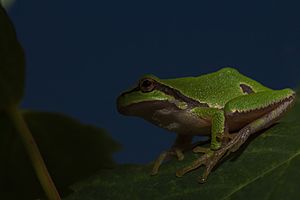European tree frog facts for kids
Quick facts for kids European tree frog |
|
|---|---|
 |
|
| Conservation status | |
| Scientific classification |
The European tree frog (Hyla arborea) is a small tree frog found across much of Europe. It's also known as the green tree frog or common tree frog. Scientists have observed these frogs in places like Crete and Greece, and across Europe, reaching as far east as central Poland and Romania.
This amazing frog is known for its ability to change color. It can be green, gray, brown, or even almost black. This helps it blend in with its surroundings. Its belly is usually white or yellow. A dark stripe runs along each side of its body, often with white edges.
What Does It Look Like?
The European tree frog has special eyes. Its pupils are shaped like a horizontal bar and can open and close up and down. This helps it see well.
One of the most interesting features of this frog is its feet. It has sticky discs on the toes of all four feet. These discs act like suction cups, helping the frog climb easily on leaves, branches, and even smooth surfaces.
You can tell male frogs apart from females. Adult male frogs have a dark-colored vocal sac on their throats. This sac inflates like a balloon when they call out. Female frogs do not have this dark vocal sac.
Where Does It Live?
These frogs love living near water in areas with lots of trees. You can find them in river valleys, forests, and even in places where humans live. They often make their homes in gardens, parks, and fruit tree farms.
During the day, the European tree frog usually hides among plants to stay safe and cool. When evening comes and it gets dark, they become active. This is when they come out to look for food.
What Does It Eat?
The European tree frog is a skilled hunter. It eats mostly insects. Because it can jump very far, it's excellent at catching flying insects like flies and mosquitoes. These make up a big part of its diet.
See also
 In Spanish: Ranita de San Antonio para niños
In Spanish: Ranita de San Antonio para niños
Images for kids
-
Formerly included in the European tree frog, the form molleri is now recognized as its own species, the Iberian tree frog
-
Hyla arborea tadpole and metamorph




